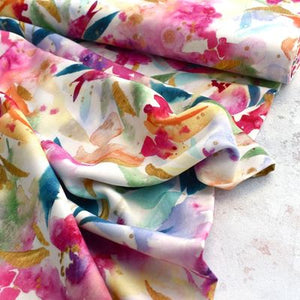While corduroy never fully disappeared from the fashion landscape, this cool-weather staple has definitely seen a resurgence in recent years. Whether it is due to the amazing texture provided by its distinct vertical pattern, or the ease with which it can be sewed up into any number of garments, corduroy is one of those classic fabrics that should be a familiar friend to just about every sewist out there.
Fabric Facts
- Most commonly known as "corduroy", this fabric also goes by aliases such as pincord, corded velveteen, manchester cloth, and elephant cord. No elephants are harmed in the making of corduroy, though some feelings were probably hurt when it gained the nickname “poor man’s velvet” in the 19th century after more costly velvet fabric came into fashion!
- Corduroy can be made from a variety of fibers, including cotton, polyester, rayon, wool, or a variety of blends of these natural and synthetic materials. It can also be produced as a stretch fabric with the addition of spandex, though the stretch percentage rarely goes above 30-40%.
- This “groovy” fabric’s characteristic look is a result of three yarns interwoven with the first two creating the flat canvas and the third used as a “pile” to create the standout lines, or “wales”.
- The number of wales within an inch of fabric is considered to be its “wale number” (super logical, right?!). The lower the wale number, the thicker the wales. So an eight-wale corduroy will have a much more prominent texture than an fourteen-wale corduroy.
- The number of wales also often corresponds to the weight of the fabric itself, with the wider/thicker wales creating beefier yardage.
- Corduroy fabric can be found in a huge variety of colors thanks to the properties of its component fibers, and their innate ability to absorb dye.

Beyond the numerous color choices available, corduroy has a variety of named types based on their unique characteristics.
- Pinwale—Sometimes referred to as “micro wale" corduroy, this includes corduroys with the finest wales, or highest wale number, often as many as 22 wales per inch. It can also be found in the widest range of weights, from shirting to bottom weights.
- Standard—With approximately 8-13 wales per inch, this form is likely what comes to mind when you picture corduroy. It is also the most commonly used for pants, overalls, and jackets.
- Elephant—Not surprisingly, this version with the widest wales of the bunch and can be found with wale numbers as low as 1.5. This is the most substantial in the corduroy family!
- Stretch—The addition of spandex allows for more flexibility and movement for the wearer. Depending on the makeup of the fabric, the direction of stretch can go in either direction, or both.
- Patterned—Though a large part of corduroy's appeal is the inherent textured design, corduroy is also produced in a variety of printed patterns like florals and paisley designs, among others.
Sew Smart! Corduroy gives makers quite a bit of options for mixing and matching to further push the creativity of your garments! You can try changing the direction of your pattern pieces so that the wales or nap are perpendicular or diagonal, or you could mix and match fabrics with different wale numbers to create visual interest and texture within outfits or garments.

Know Before You Sew
- Corduroy is a napped fabric, meaning it reflects light differently depending on the angle. Keep this in mind when ordering yardage, you may need to allow for extra yardage so that you can cut all of your pieces going the same direction to prevent variation in color/texture.
Sew Smart! Figure out the direction of the nap by brushing your hand along the grainline. It will feel smoother going with the nap and more coarse when going against it. Corduroy garments typically run the length of the garment against the nap. Meaning, if you run your hand down your pant leg or sleeve, it will feel rough, rather than smooth. This gives the most vibrant color!
- Test your pattern weights on a corner of the fabric to ensure that they are not too heavy to crush the corduroy wales as you cut.
- Be very, very careful any time your pattern calls for pressing your fabric, as corduroy wales can easily be crushed under the combination of your iron’s weight and heat. Always use the lowest possible temperature with the wales of the fabric facing down and resting on a soft surface, such as a fluffy bath towel.
- When sewing with a heavy weight corduroy, here are a few other things to consider:
- Take the time with a two-layer swatch of fabric to ensure that your needle selection, stitch length, tension, and presser foot are the best and easiest to sew your garment. Depending on the width of the wales, you may find it is easier to use a longer stitch, loosen your upper tension, or even use a non-stick foot for a smoother sewing experience.
- Help minimize bulk by utilizing a lighter weight fabric for any linings, pockets, or facings.
- Absolutely do not skip any grading or trimming of seams!
Sew Smart! Give thick corduroys a haircut! Many sewists swear by the technique of carefully shaving down the pile of their corduroy with hair clippers, to remove some of its height around areas that often create bulk such as hems, necklines, cuffs, and seams!

TFC (Tender Fabric Care)
- Always check the care instructions on your fabric to ensure that it can be machine-washed and doesn’t require dry cleaning.
- Wash your corduroy inside out in the recommended temperature. This will help to maintain the integrity of the wales and avoid having them crushed.
- Never, ever wash your corduroy with another material that produces lint! You will find that its nap and grooves can make it a lint magnet and you will find yourself losing precious moments of your life tediously removing the remnants of other garments!
- If you do find a lint build-up on your corduroy, gently remove it with a lint roller, a clothes brush or even some packing tape wrapped around your hand. Like wood, always work in the direction of the grain/nap, rather than against.
- Corduroy is best air-dried and most wrinkles will release on their own with a good, firm shake. Be aware of the clothes pins you use to hang your garments though, as they may crush your wales. Using a buffer of a thick, soft fabric between your pins and your garment should eliminate this issue.

Sew What?
- Similar to denim, corduroy is a wonderfully durable fabric that lends itself to a wide variety of me-made projects.
- In heavier weights, it is a favorite for cool-weather and hard working garments like pants, overalls, jackets, blazers, and fitted skirts.
- Lighter-weight pinwale corduroys are well suited button-up shirts, dresses, and skirts to wear year-round. They can also often be found in brighter colors, making them a great choice for kids clothes.
- Other uses include accessories such as hats and bags or home décor items like pillows and floor poufs. All of which are immediately given more visual interest with the added texture brought by corduroy’s signature grooves!
We SEW Want To Know What You Think! What are some of your favorite projects you've constructed with corduroy?







Oh dear. I was kneeling on my corduroy on the floor, tracing the pattern, and I did nothing what I can now see is called crushing. I assumed it would voice back after a washing. Is that true, or a totally false assumption?!
If the recommendation is to wash corduroy inside out and to air dry, should the fabric be pre-washed? Thanks much for your fabric profiles. Very informative!
I made a pair of navy corduroy overalls that are so cute and comfy!! By far my favorite corduroy project (so far!)…
Leave a comment